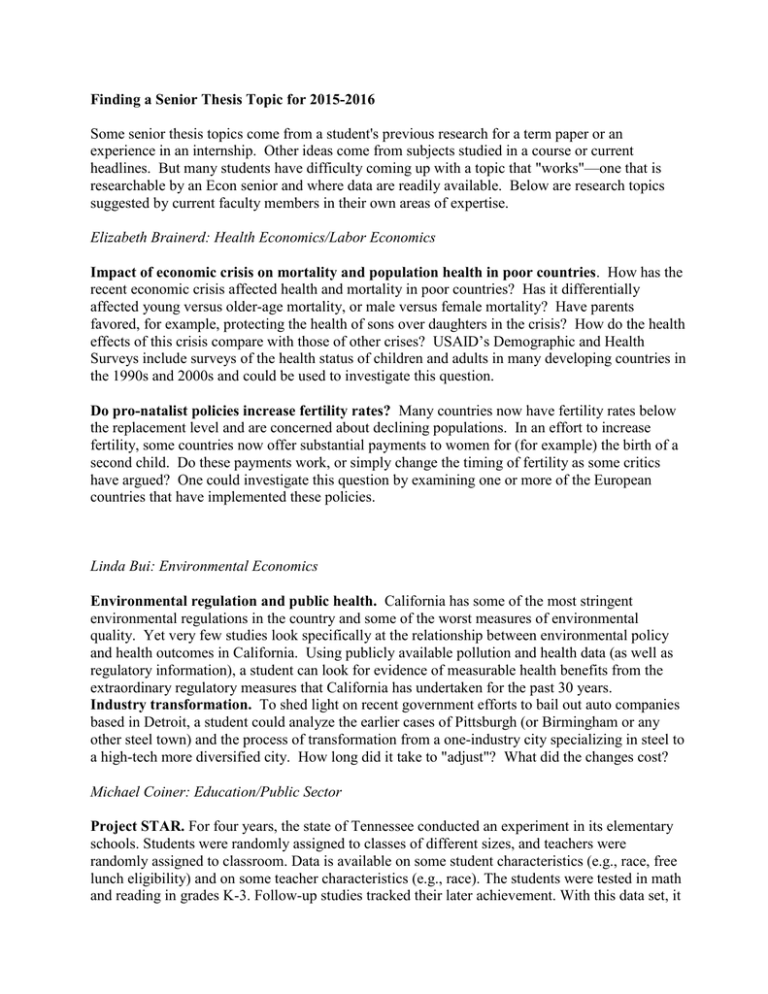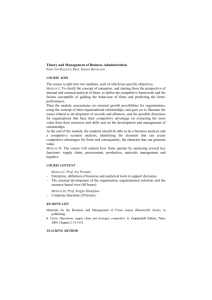Finding a Senior Thesis Topic for 2015-2016
advertisement

Finding a Senior Thesis Topic for 2015-2016 Some senior thesis topics come from a student's previous research for a term paper or an experience in an internship. Other ideas come from subjects studied in a course or current headlines. But many students have difficulty coming up with a topic that "works"—one that is researchable by an Econ senior and where data are readily available. Below are research topics suggested by current faculty members in their own areas of expertise. Elizabeth Brainerd: Health Economics/Labor Economics Impact of economic crisis on mortality and population health in poor countries. How has the recent economic crisis affected health and mortality in poor countries? Has it differentially affected young versus older-age mortality, or male versus female mortality? Have parents favored, for example, protecting the health of sons over daughters in the crisis? How do the health effects of this crisis compare with those of other crises? USAID’s Demographic and Health Surveys include surveys of the health status of children and adults in many developing countries in the 1990s and 2000s and could be used to investigate this question. Do pro-natalist policies increase fertility rates? Many countries now have fertility rates below the replacement level and are concerned about declining populations. In an effort to increase fertility, some countries now offer substantial payments to women for (for example) the birth of a second child. Do these payments work, or simply change the timing of fertility as some critics have argued? One could investigate this question by examining one or more of the European countries that have implemented these policies. Linda Bui: Environmental Economics Environmental regulation and public health. California has some of the most stringent environmental regulations in the country and some of the worst measures of environmental quality. Yet very few studies look specifically at the relationship between environmental policy and health outcomes in California. Using publicly available pollution and health data (as well as regulatory information), a student can look for evidence of measurable health benefits from the extraordinary regulatory measures that California has undertaken for the past 30 years. Industry transformation. To shed light on recent government efforts to bail out auto companies based in Detroit, a student could analyze the earlier cases of Pittsburgh (or Birmingham or any other steel town) and the process of transformation from a one-industry city specializing in steel to a high-tech more diversified city. How long did it take to "adjust"? What did the changes cost? Michael Coiner: Education/Public Sector Project STAR. For four years, the state of Tennessee conducted an experiment in its elementary schools. Students were randomly assigned to classes of different sizes, and teachers were randomly assigned to classroom. Data is available on some student characteristics (e.g., race, free lunch eligibility) and on some teacher characteristics (e.g., race). The students were tested in math and reading in grades K-3. Follow-up studies tracked their later achievement. With this data set, it is possible to investigate a number of questions regarding the effects of smaller classes and different kinds of teachers on different groups of students, and whether these effects persisted over time. Massachusetts Health Care Reform. In 2006 Massachusetts undertake health care reform. The Massachusetts effort served as the model for the national health reform law that was passed in 2010. What were the major features of the Massachusetts reform, and what have its effects been on the number of people with health insurance, on health care costs, and on health care quality? Kathryn Graddy: Micro/Industrial Organization/Finance Prof. Graddy has three different datasets students are welcome to use for any senior thesis project: Data on violin prices at auction – one dataset is a repeat-sales dataset from 1855 to present and another dataset contains detailed individual data from 1980 to present. Data on art sold at auction between 1980 and 1992. Real estate data from the MLS – for example all homes listed in Boston and suburbs during January 2003. Some specific ideas for using these datasets: Violins as assets. Estimate a CAPM model using detailed violin data. Prof. Graddy can supply the violin data, but the student will need to download relevant stock and bond data and understand how to estimate the model. Testing for optimizing behavior by impressionist artists. Estimate the price-per-square-foot for impressionist art, and then determining whether or not the majority of artists are optimizing. House prices and school rankings. Using the MLS data, one might be able to correlate real estate prices to school ranking in the Boston area and then explain why the correlation is as it is. Gary Jefferson: R&D spending/China From 1996 to present, the ratio of R&D spending to GDP in China has risen from 0.6% to over 2%, now matching the OECD countries. What is motivating the increase? Who Performs R&D and Why? Data set: most of China’s large, medium, and small manufacturing firms – a panel of about 400,000 firms spanning 1998-2007. Includes data on R&D, exports, new product innovation, and other relevant measures. How does Patenting in China's Renewable Energy Sector Compare with that of the U.S.? This will entail accessing patent data from China's State Intellectual Property Office and the U.S. Patent and Trademark Office comparing the quantity and quality of such patenting over the past decade. 2 Davide Pettenuzzo: Econometrics Degree to which stock return predictability changed over time. Historical data on the aggregate S&P 500 index and most of the key macroeconomic and financial indicators that have been found to be useful predictors of returns are available from Amit Goyal’s website at http://www.hec.unil.ch/agoyal/docs/PredictorData2010.xls. Professor Pettenuzzo has been working with this data recently and would be happy to advise students that would like to work with it. Some interesting questions worth exploring are related to the degree to which stock return predictability changed over time. For example, the five-year period between 1990 and 1995 has been found to be one the most detrimental time period for the hypothesis that stock returns can, at least to some extent, be predicted. Various hypotheses have been suggested as possible explanations for this significant change in predictability, but there is no clear consensus on which institutional or macroeconomic factor might best suited to explain this phenomenon. The question of what generated this change in predictability is still quite open. Scott Redenius: Economic History/Economics of Financial Institutions Railroad profits and investment. The period from the Civil War to World War I was the golden age of American railroads. Railroad mileage grew dramatically over the period but at a very uneven pace. Large portions of the railroad network were laid down in relatively brief spurts followed by periods of limited growth and, in some cases, bankruptcies or restructuring. What explains the pattern of railroad expansion over this period? The January effect. The efficient market hypothesis predicts that stock prices should not exhibit predicable patterns but should move randomly. However, small stocks tend to exhibit abnormally high returns from late December through early January. Recent work indicates that the January effect has become smaller over time – and some claim that it has disappeared altogether. What generated the January effect and what explains its decline in the past two decades? Raphael Schoenle: International Macroeconomics, Macroeconomics Price Dynamics. Prof. Schoenle has worked with the micro data underlying the CPI, PPI and IPP (US export and import prices) published by the BLS. Very disaggregated data for these series are published online by the BLS at http://www.bls.gov. There is detailed online documentation about these datasets available in the form of the BLS Handbook and FAQs. Many policy questions can be addressed by studying these data such as: How does a large appreciation of the Chinese Yuan pass through into US import and domestic prices? How do various measures of the exchange rate pass through into US import prices? Do domestic, export and import price indices show consistent price dynamics for example for computer electronics prices? Prof. Schoenle has worked extensively with these data and is happy to advise students interested in working on US price dynamics. Elif Sisli Ciamarra: Corporate Finance Governance of mutual fund firms. The aim of the study is to examine whether different corporate governance practices of mutual fund companies have any effect on the returns to mutual 3 fund investors. The emphasis will be on the different board structures of the mutual fund companies (whether the different funds under the same mutual fund family group share a board of directors). The project involves collecting data on mutual fund board characteristics and managerial characteristics, and then analyzing whether (a) the performance of the fund is higher under any board structure, and (b) there is less performance transfer to the star funds under any board structure. Executive Compensation and Risk Taking in the Banking Sector. This study will analyze how different components of executive compensation packages (salary, bonus, stock-based awards, pension contributions) affects the executive risk-taking in the banking industry. The project involves (a) organizing the compensation data, (b) developing risk-taking measures for the banking industry, (c) using econometric techniques to investigate the relation between executive compensation and risk-taking. Diversification effects in biopharmaceutical firms. Several studies indicate that diversified firms trade at an average discount relative to specialized firms in the same industries (Lang and Stulz, 1994; Berger and Ofek, 1995; Servaes, 1996). However, Villalonga (2004) argues that the computed diversification discounts in the prior studies is merely a “data artifact” because the use of segment data introduces a noise by breaking down the activities of firms by industries inconsistently across firms. Thus, the presence of a “diversification discount” is still an open debate in corporate finance. Using a hand-collected dataset on drug development activities of U.S. pharmaceutical companies, we will try to perform tests of effects of diversification at a product level. Dan Tortorice: Macroeconomics Consumer expectations and buying attitudes. The micro data from the Michigan Survey of Consumers is all available on-line at http://www.sca.isr.umich.edu/. Prof. Tortorice has worked with this data in the past and would be happy to advise someone who wants to work with it. The documentation is online so a student can browse through the variables and come up with some questions that the data can be used to answer. The Survey of Consumers is a monthly survey of the economic expectations and buying attitudes of U.S. households. It covers personal finances, business conditions, and buying conditions. The variables include assessments of personal finances, expected changes in family income, and attitudes towards business conditions in the economy as a whole, over the near and the long-term horizon. It also contains expected changes in inflation, unemployment, and interest rates, as well as confidence in government economic policies. Finally, it includes each respondent's view on market conditions for buying large household durables, vehicles, and houses. Several demographic variables, e.g. education, age, race and gender, are available as well. 4




